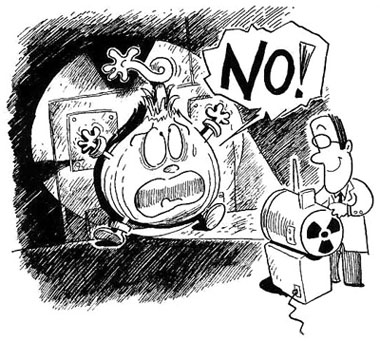Promoting Food Irradiation Without First Verifying its Safety Nuke Info Tokyo No. 114
Summary of article by Dr. Hiroshi Satomi of the Food Irradiation Network
The Atomic Energy Commission (AEC) decided in 1965 to develop food irradiation as part of a policy of promoting multiple applications of nuclear energy. Specifically, it chose seven products: rice, wheat, potatoes, onions, mandarin oranges, wiener sausages and seafood pastes such as kamaboko. In 1972 the Ministry of Health and Welfare approved the irradiation of potatoes with up to 150 grays (Gy) to prevent sprouting, and in 1974 the agricultural cooperative of Shihoro in Hokkaido began sending irradiated potatoes to market. Consumers were not told that these potatoes were about to appear in the stores until immediately before the event.
The government failed to take into account the fact that new technology such as this could be misused. Mothers were shocked to discover in 1978 that a subcontractor of Wakodo had irradiated ingredients for baby food with up to 30,000 Gy. They were particularly concerned, because research on rats carried out under the nuclear section of the Science and Technology Agency had shown that irradiated food causes deformities, reduced body weight, reduced weight of ovaries and testicles, and an increased fatality rate. A movement against food irradiation arose and many municipalities, including Tokyo, requested Shihoro agricultural cooperative not to ship irradiated food to their markets.
After that, the other six products did not receive approval and it seemed that irradiated food had disappeared. However, in October 2005 AEC adopted a policy of promoting food irradiation in its Framework for Nuclear Energy Policy. It said, “it is important to close the information gap, regarding information of available technologies including their merit and safety, for potential users” (English version, p.36). AEC’s Special Committee on Food Irradiation released a draft report on July 13th, in which it concluded that this lack of understanding is the reason why irradiated food has not taken off. It recommended allowing irradiation of the 94 spice and herb products requested by the All Nippon Spice Association, vegetables, and so on. Some of the problems with this report are discussed below.
 |
|
Cartoon by Shoji Takagi
|
The report dismissed deformities found in mice which had been fed irradiated onions, implying that these were caused by onion itself rather than by irradiation. However, the study cited in support of this position failed to prove the case. The report also rejected claims that substances (cyclobutanons) produced in irradiated food as a result of irradiation cause genetic damage, or that they are carcinogenic, despite evidence to the contrary from German research (Federal Research Center for Nutrition Karlsruhe, 1998). The report acknowledged that irradiation sometimes gives rise to odors, which are thought to come chiefly from sulfur-containing amino acids in protein, or from fats. It recognized that this is a problem for marketing, but noted the view that it is not a problem for health. However, the report gave no indication of who said that this is not a problem for health. Unscientific claims like this are littered throughout the report. They bring into question the Special Committee’s impartiality, its scientific objectivity and its ability.In 1980, AEC’s Special Committee decided that irradiated food was safe, based on the conclusion of a joint expert committee of FAO, WHO and IAEA. That committee had concluded that food irradiation up to 10,000 Gy did not cause problems. This conclusion took into account Japanese research into the effects of irradiated potatoes on rats. However, it misrepresented the results of that research. In fact, the Japanese research had acknowledged that potatoes irradiated by as little as 300 Gy and 600 Gy affected the body weight and the weight of the ovaries of rats. Far from confirming that irradiated food is safe, it showed that it is dangerous. At the time, no ill effects had been found from irradiating potatoes with 150 Gy, so this was set as the limit for irradiated potatoes. Deformities were found in second-generation rats from onions irradiated with 150 Gy, but since no application for approval was submitted for irradiated onions, they were not assessed.
The Japanese research into potatoes was a big obstacle for the international promoters of irradiated food, who wanted to show that irradiation was safe up to 10,000 Gy. The FAO/WHO/IAEA expert committee attempted to negate the Japanese research in WHO Technical Report No. 604, published in 1977. It acknowledged that a statistically significant change in the size of ovaries had been observed in rats, but implied that irradiation was safe because problems had not been observed from the perspective of tissue pathology. However, given that the weight of the ovaries was reduced by as much as one-third in the Japanese experiments, if the cells themselves were normal, one must conclude that the number of cells was reduced.
AEC’s Special Committee’s 1980 conclusion that food irradiation up to 10,000 Gy is safe was based on the 1977 FAO/WHO/IAEA report’s willful misinterpretation of the Japanese data. It is a great mistake that the Special Committee is now proposing that food irradiation be permitted, without first revisiting the dubious basis of its claim that food irradiation is safe. At least the FAO/WHO/IAEA report acknowledged the need for more experiments into changes induced by irradiated food in the ovaries and testicles of rats. However, AEC is ignoring this caution. It has a responsibility to the public to provide scientific answers to this and other outstanding questions. The draft report fails to do this, so it will not generate public confidence in irradiated food.

